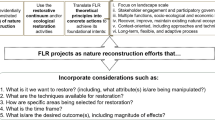Abstract
The limits of acceptable change (LAC) planning framework recognizes that forest managers must decide what indicators of wilderness conditions best represent resource naturalness and high-quality visitor experiences and how much change from the pristine is acceptable for each indicator. Visitor opinions on the aspects of the wilderness that have great impact on their experience can provide valuable input to selection of indicators. Cohutta, Georgia; Caney Creek, Arkansas; Upland Island, Texas; and Rattlesnake, Montana, wilderness visitors have high shared agreement that littering and damage to trees in campsites, noise, and seeing wildlife are very important influences on wilderness experiences. Camping within sight or sound of other people influences experience quality more than do encounters on the trails. Visitors’ standards of acceptable conditions within wilderness vary considerably, suggesting a potential need to manage different zones within wilderness for different clientele groups and experiences. Standards across wildernesses, however, are remarkably similar.
Similar content being viewed by others
Literature Cited
Driver, B. L., R. Nash, and G. Haas. 1987. Wilderness benefits: A state-of-knowledge review. Pages 294–319in R. C. Lucas (compiler), Proceedings, National wilderness research conference: Issues, state-of-knowledge, future directions. Fort Collins, Colorado, 23–26 July 1985. USDA Forest Service General Technical Report INT-220, 369 pp.
Gorsuch, R. L. 1983. Factor analysis. Lawrence Erlbaum, Hillsdale, New Jersey.
Hendee, J. C., G. H. Stankey, and R. C. Lucas. 1990. Wilderness management. North American Press, Fulcrum Publishing, Golden, Colorado, 546 pp.
Lucas, R. C. 1980. Use patterns and visitor characteristics, attitudes, and preferences in nine wilderness and other roadless areas. USDA Forest Service Research Paper INT-253, 89 pp.
Lucas, R. C., and G. H. Stankey. 1985. Role of research in applying the limits of acceptable change system. Pages 1–15in A. E. Watson (ed.), Proceedings, southeastern recreation research conference, Myrtle Beach, South Carolina, 28 February–1 March 1985. Department of Recreation and Leisure Services, Georgia Southern College, Statesboro, Georgia, 144 pp.
Manfredo, M. J., B. L. Driver, and P. J. Brown. 1983. A test of concepts inherent in experience based setting management for outdoor recreation areas.Journal of Leisure Research 15(3):263–283.
McCool, S. F., and R. C. Lucas. 1990. Managing resources and people in wilderness: Accomplishments and challenges. Pages 64–75in D. W. Lime (ed.), Managing America’s enduring wilderness resource. Proceedings of the conference. Minneapolis, Minnesota, 11–17 September 1989. Tourism Center, Minnesota Extension Service and Minnesota Agricultural Experiment Station, University of Minnesota, St. Paul, Minnesota, 706 pp.
McCool, S. F., J. L. Ashor, and G. L. Stokes. 1986. An alternative to rational-comprehensive planning: Transactive planning. Pages 544–545in R. L. Lucas (compiler), Proceedings, National wilderness research conference: Current research, Fort Collins, Colorado, 23–26 July 1985. USDA Forest Service General Technical Report INT-212, 553 pp.
Merigliano, L. L. 1990. Indicators to monitor the wilderness recreation experience. Pages 156–162in D. W. Lime (ed.), Managing America’s enduring wilderness resource. Proceedings of the conference, Minneapolis, Minnesota. 11–17 September 1989. Tourism Center, Minnesota Extension Service and Minnesota Agricultural Experiment Station, University of Minnesota, St. Paul, Minnesota, 706 pp.
Nash, R. 1982. Wilderness and the American mind. Yale University Press, New Haven, Connecticut, 425 pp.
Roggenbuck, J. W., and R. C. Lucas. 1987. Wilderness use and user characteristics: A state-of-knowledge review. Pages 204–245in R. C. Lucas (compiler), Proceedings, National wilderness research conference: Issues, state-of-knowledge, future directions. Fort Collins, Colorado, 23–26 July 1985. USDA Forest Service General Technical Report INT-220, 369 pp.
Roggenbuck, J. W., and M. J. Manfredo. 1990. Choosing the right route to wilderness education. Pages 102–112in D. W. Lime (ed.), Managing America’s enduring wilderness resource, Proceedings of the conference, Minneapolis, Minnesota, 11–17 September 1989. Tourism Center, Minnesota Extension Service and Minnesota Agricultural Experiment Station, University of Minnesota, St. Paul, Minnesota, 706 pp.
Roggenbuck, J. W., A. E. Watson and G. H. Stankey. 1982. Wilderness management in the southern Appalachians.Southern Journal of Applied Forestry 6(3):147–152.
Roth, D. M. 1984. The wilderness movement and the national forests: 1964–1980. USDA Forest Service Forest History Series FS 391, 70 pp.
Shelby, B. 1981. Encounter norms in backcountry settings: Studies of three rivers.Journal of Leisure Research 13(2):129–138.
Stankey, G. H. 1973. Visitor perception of wilderness recreation carrying capacity. USDA Forest Service Research Paper INT-142, 61 pp.
Stankey, G. H. 1980. A comparison of carrying capacity perceptions among visitors to two wildernesses. USDA Forest Service Research Paper INT-242, 34 pp.
Stankey, G. H., and R. Schreyer. 1987. Attitudes toward wilderness and factors affecting visitor behavior: A state-of-the-knowledge review. Pages 246–293in R. C. Lucas (compiler), Proceedings, National wilderness research conference: Issues, state-of-knowledge, future directions, Fort Collins, Colorado, 23–26 July 1985. USDA Forest Service General Technical Report INT-220, 369 pp.
Stankey, G. H., D. N. Cole, R. C. Lucas, M. E. Petersen, and S. S. Frissell. 1985. The limits of acceptable change (LAC) system for wilderness planning. USDA Forest Service General Technical Report INT-176, 37 pp.
Stokes, G. L. 1990. The evolution of wilderness management: The Bob Marshall Complex.Journal of Forestry 88(10):15–20.
USDA Forest Service. 1987. Bob Marshall, Great Bear, and Scapegoat wildernesses recreation management direction. Flathead, Lolo, Helena, Lewis & Clark national forests. 15 pp.
Author information
Authors and Affiliations
Rights and permissions
About this article
Cite this article
Roggenbuck, J.W., Williams, D.R. & Watson, A.E. Defining acceptable conditions in wilderness. Environmental Management 17, 187–197 (1993). https://doi.org/10.1007/BF02394689
Issue Date:
DOI: https://doi.org/10.1007/BF02394689




